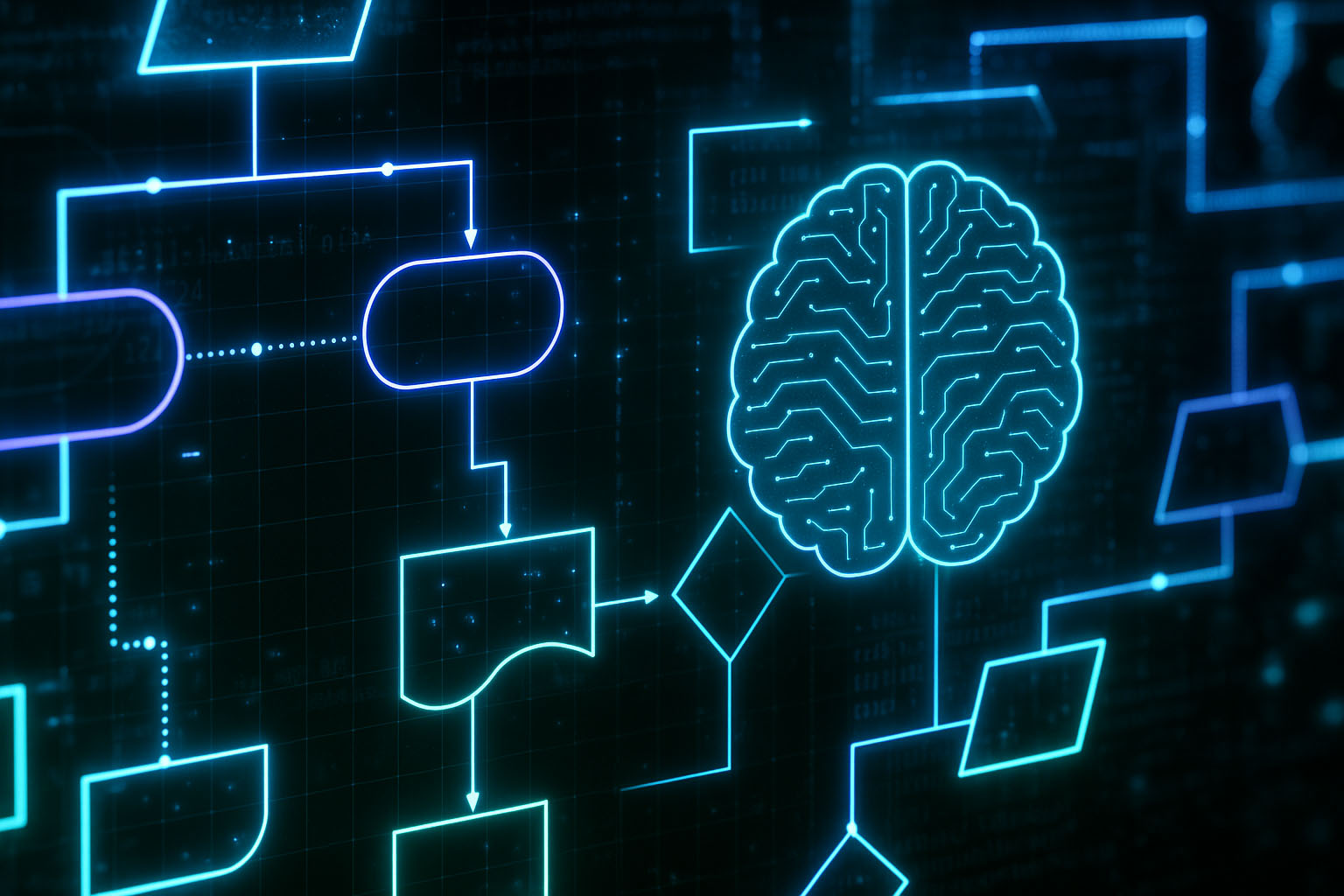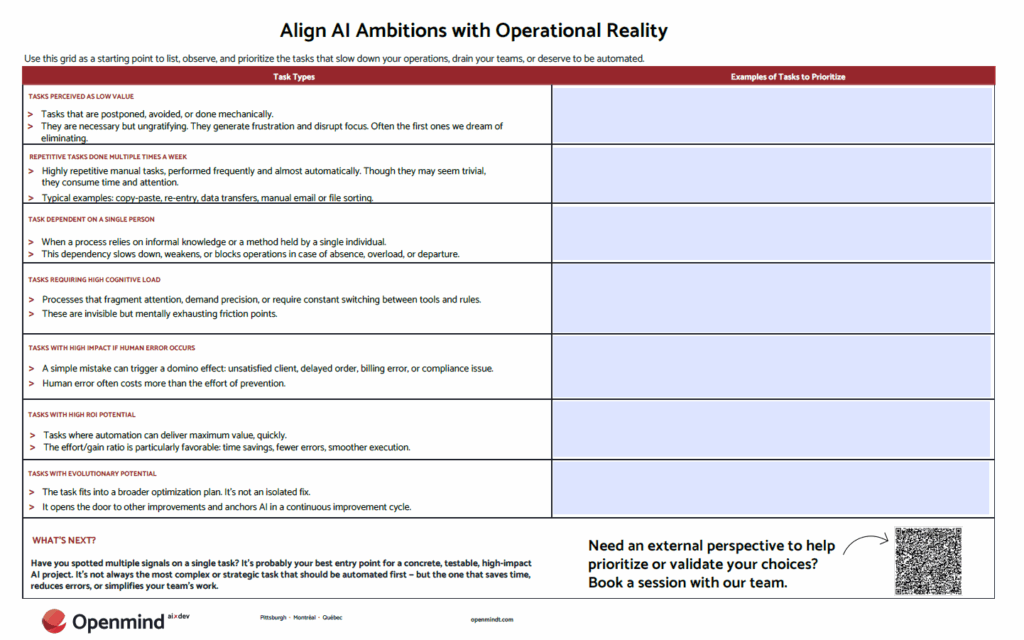Prioritize the right tasks to make your AI project successful
Spot the right tasks. Unlock real impact. Build AI use cases that matter for your business.

In a previous blog, we clarified the difference between a manual workflow, a traditional coded automation, and an intelligent workflow powered by an AI agent.
That framework laid the groundwork: how organizations move from a fully human-driven process, to a rigid automation, and finally to something that’s actually intelligent.
Here, we’re taking things a step further.
In the automation landscape, two ideas come up all the time and often get mixed up: the AI-enhanced workflow and the AI agent. Both use artificial intelligence, but they operate very differently and don’t have the same scope at all.
The first one plugs itself into a deterministic, well-defined process; the second one acts on its own and makes decisions based on whatever context it sees.
This distinction alone can make or break an automation project.
So here’s what we’re doing next:
And to make all this more concrete, you’ll be able to download our AI Task Prioritization Grid at the end, a practical tool to spot which processes are the best candidates for automation before you jump in.
Objective: Understand the difference between an AI-enhanced workflow and an AI agent, and know in which situations you should use one or the other.
What is an AI-enhanced workflow?
An AI workflow is, before anything else, a structured process made of known, predefined steps.
In other words, you already know exactly what happens at each branch:
if scenario A shows up, you follow branch A; if it’s scenario B, you go to branch B, and so on. It’s a deterministic logic where all possible paths are laid out ahead of time.
Artificial intelligence doesn’t replace that structure.
It plugs into it locally, at specific points in the process, to mimic a bit of human reasoning and improve decision-making.
Put simply — without falling into jargon — it’s basically an automation that’s been augmented with artificial intelligence.
Let’s take a very common case in most companies. Every day, supplier invoices come in, often in all kinds of formats. The typical steps are straightforward:
Before, this extraction step required OCR templates built separately for every supplier — a long and fragile piece of work.
With an AI workflow, that step becomes “smart”: the AI reads and understands the invoice directly, pulls out the right fields (amount, vendor name, date, taxes), and then lets the process continue normally.
“The goal is to automate a process you already know, but make certain steps smarter with a digital brain.”
The result: a process that stays predictable and stable, but handles its friction points much more autonomously.
The AI doesn’t take over the workflow, it reinforces it.
What is an AI agent?
An AI agent is built around one core idea: autonomy.
Where a workflow follows a scenario defined in advance, the agent receives a mission and figures out by itself the best way to accomplish it.
It doesn’t just run through a list of steps, it actually reasons.
An AI agent is built to act on its own, not simply execute steps. It plans, acts, watches the results, and then adjusts its behavior continuously.
A concrete example: preventive maintenance
Imagine a fleet of machines or vehicles. The mission given to the AI agent is simple, anticipate possible breakdowns. To do that, it relies on several sources of information:
By combining all of this, the agent might come to a conclusion like:
“Machine number 34 is showing an abnormal vibration. An inspection should be planned within 48 hours, since there’s an opening in the production schedule.”
From there, it can act on its own: create a maintenance ticket, notify the mechanics team, adjust the task priority if the problem worsens.
And above all, it repeats this cycle several times a day as new data comes in.
The AI agent observes, understands, acts, and readjusts — without following a predetermined sequence.
It behaves like a living, adaptive system, adjusting its actions based on context and available data. As the diagram below shows, it relies on three essential levers: access to memory, data, and tools, which it mixes together to achieve the mission it has been given.
The AI workflow, on the other hand, executes a fixed and structured logic where AI only steps in at specific points. Where the workflow stays on a predefined path, the agent draws its own route.
The first one aims for reliability.
The second bets on flexibility.
The difference ultimately comes down to the type of control: deterministic on one side, autonomous on the other.
The choice between an AI workflow and an AI agent depends mainly on the kind of result you expect.
An AI workflow delivers consistent, predictable outcomes, but it requires more upfront work. You need to anticipate all possible scenarios: branches A, B, C, and the actions tied to each one.
“You have to plan for every possible case, but once it’s well built, the workflow becomes very efficient in day-to-day operations.”
This is the right approach when you’re aiming for stability and error-free repetition.
An AI agent, on the other hand, is faster to set up for complex or evolving tasks. It adapts to the context and keeps learning, but its results can vary from one situation to another.
“The more you’re looking for stability and predictability, the more you go toward an AI workflow. The more you want a system that adapts, the more you go toward an AI agent.”
It’s the best option when the environment changes often and you can tolerate a bit of unpredictability.
In reality, the line between them is rarely clean
In reality, the line between them is rarely clean. Many projects mix both approaches: an AI workflow can embed an agent to handle fuzzy scenarios, or an agent can trigger workflows when needed.
“You can have a workflow that contains an agent, or an agent that runs workflows. You have to test and iterate to find the right balance.”
This hybrid approach lets you pull the best from both sides: the workflow’s reliability and the agent’s flexibility.

Spot the right tasks. Unlock real impact. Build AI use cases that matter for your business.

Conclusion
AI workflows and AI agents aren’t opposites.
They actually work well together. One brings structure and stability, the other takes action — observing, adjusting, and adapting when things change.
An AI workflow gives you reliability and predictability in day-to-day operations.
An AI agent brings flexibility and the ability to adjust in more open, uncertain environments.
The real risk today is getting carried away by the hype.
“The term ‘AI agent’ sounds exciting, but in most cases, the AI workflow is still the most reliable solution for a company.”
The smart move is to try both approaches on a small scale and validate what each one brings.
Test, observe, iterate — until you find the right balance between control and autonomy.
And if you’re wondering where to start, Openmind’s AI Task Prioritization Grid is the best first step. It helps you align your AI ambitions with the real operational needs of your teams.
What’s the main difference between an AI workflow and an AI agent?
An AI workflow follows a predetermined scenario, while an AI agent acts on its own based on a broader mission.
Does an AI agent replace a workflow?
No. They solve different problems and often work best when they coexist in the same system.
Can an AI agent be integrated into an existing workflow?
Yes. You can plug agents into workflows to make certain parts more adaptable.
How do I know which approach to choose?
Look at the level of reliability you need and how complex or unstable the process is. Workflows fit stable, predictable scenarios; agents fit situations that change often.
How do I identify the best tasks to automate?
Use Openmind’s AI Task Prioritization Grid to spot high-impact tasks and shape your first prototypes.
Subscribe to receive our updates directly to your email.

Tell us more about your needs so that we can better route your project to our specific SWAT team.
1
During the brainstorming phase, we work with you to identify potential solutions to your business challenges to generate the technology response that aligns with your business objectives.
2
Through our requirements gathering process, we work closely with you to define and prioritize your needs, ensuring that our solutions are tailored to meet your specific requirements.
3
This phase marks the beginning of our partnership. We’ll finalize the project plan and establish clear communication channels to ensure a smooth and successful project execution.